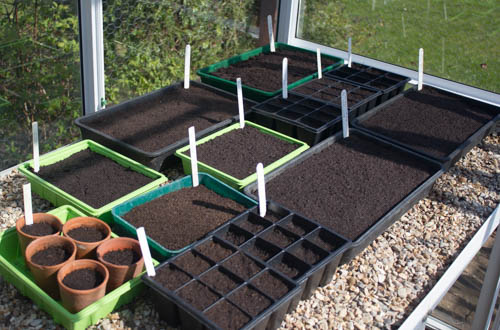
Sow broad beans, spinach, cabbage, calabrese, kohlrabi, cauliflower, lettuce, peas for pods and shoots onions, salad onions, turnip, radish, beetroot, leeks, leaf beat and chard under glass. From the middle of the month onwards, sow dill, basil, coriander indoor cucumber, courgette, squash, sweetcorn and tomatoes for later transplanting outdoors. Protect peas, broad beans and sweetcorn from mice. If you are having this spell of warm days and cold nights, it is a good time to sow parsley as the ‘highs and low’s break the seed dormancy; always use fresh seed as viability is short. Sow celeriac, spinach and turnip early in the month. Most seed is sown in seed compost, or finely sieved multipurpose compost, larger seeds like peas and beans can be sown in straight multipurpose compost having picked out the uncomposted bits.
It is also time to sow half hardy annuals like Cleome hasselriana ‘Violet Queen’. Like all of the half hardy annuals and others grown in the greenhouse, they will need ‘hardening off’ ready for transplanting once the danger of frost has passed and the soil has warmed.
Keep the greenhouse well ventilated and cover tender plants with fleece at night if the greenhouse is unheated; shade seedlings with newspaper or fleece on the day, to prevent them from scorching.
Repot tender plants into new compost before they start into growth. Organic composts break down after a couple of years in warm conditions.
When shoots appear on tuberous begonias, thin them to leave only the strongest. Repot and water hippeastrums as they start into growth.
Sow melons, squash and cucumber seeds on edge in modules or 7.5cm pots of multipurpose or John Innes no 1 potting compost ready for planting out in May once the danger of frost has passed. They can be germinated on a windowsill or propagator at 15-18C (60-65F) and the compost kept moist with tepid water.
Prick out Peppers and Aubergines into modules or individual post once the seed leaves have expanded.
I have grown unusual vegetables for years, inspired by a book I bought in 2004 by Simon Hickmott called Growing Unusual Vegetables: Weird and Wonderful Vegetables and How to Grow Them. It is fascinating to try something different. Plants like Chickpeas, Asparagus peas, red orach, Achocha, amaranth, Quinoa and Perilla have all been very successful and are among those mentioned in Incredible Edibles. All are very resilient to pests and diseases, as they are not highly bred and very close to the wild species or are the wild species themselves.
Some like Chickpeas grow well in very poor soil. Start them indoors in root trainers or 8cm pots of compost, water and put them in a propagator or on a sunny windowsill at 12-25C to germinate. They take from 10-25 days to germinate depending on the temperatures and need hardening off before transplanting. They can also sown direct from early April. Each pod only produces two or three seeds but it is very exciting to be able to harvest your own chick peas. The incentive is homemade hummus. Happy Gardening. Matt


